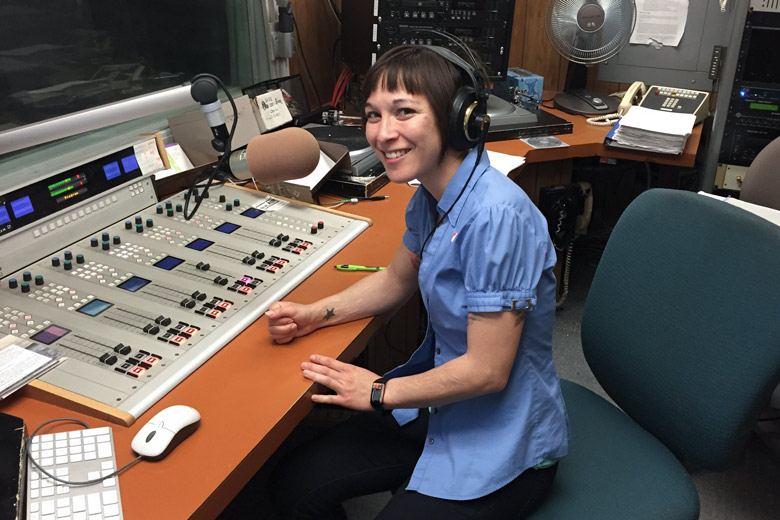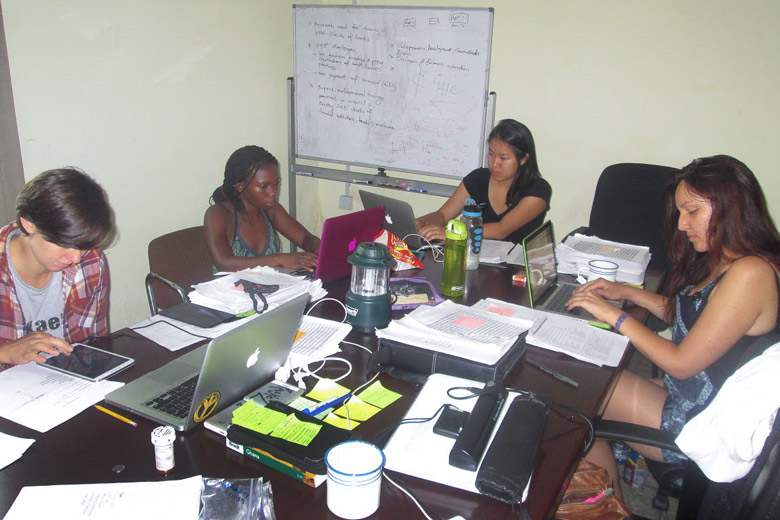Stanford undergrads explore the power of storytelling with audio documentaries
From orphans in Ghana to drag queens in San Francisco – Stanford students in a storytelling program have learned about communities, events and traditions both foreign and familiar. In April the latest audio documentaries will be aired on campus radio station KZSU and released online on the Stanford Storytelling website.

Stanford student Mischa Shoni interviewed people across the country for her audio documentary on mental health. (Image credit: Courtesy Mischa Shoni)
“I am seeking stories from accidental explorers of non-traditional realities, spiritual dimensions, labyrinths, mazes and enchanted-else-wheres.”
So began a call for stories issued by Stanford senior Mischa Shoni, as part of a radio project she produced with the support of a Braden Storytelling Grant.
Winners of the grant are awarded up to $3,000 to research and create an audio documentary based on oral history archives or interviews conducted by the student. Each documentary examines a particular event, community or tradition.
The grant is part of the Stanford Storytelling Project, described on its website as an arts program that “explores how we live in and through stories and, even more importantly, how to deepen our lives through our own storytelling.” To date, 18 students have produced 16 documentaries that have aired on Stanford radio station 90.1 KZSU. Braden documentaries can be found on the Stanford Storytelling Project website.
Sophomore Christine Chen said making her 26-minute documentary about orphanages in Ghana “was one of the most important things in terms of my personal growth and developing my own self-confidence. I look back and I realize what I am capable of.”
Now in its fourth year, the Braden Grants committee will be accepting student proposals for the 2015-216 year until April 15. The grant was created to give students the opportunity to turn research into the kind of story you hear on increasingly popular podcasts like Radiolab, 99% Invisible and Invisibilia.
“We look for all kinds of stories,” said Jonah Willihnganz, director of the Stanford Storytelling Project, which manages the Braden Grants. “In the past students have produced stories about nearly extinct species, drag queens, orphanages in Uganda – you name it.”
Shoni’s documentary, Of Madness and Magic: Shifting the Lens to Understand the Mind, shares the stories of people who have experienced upheavals in their mental state but go beyond psychiatry for explanations and meaning.
The topic interests Shoni as a psychology student, but for her this is not just an academic exploration. The documentary begins with Shoni describing a day in her own life when her perception of reality changed, and suddenly, she said, “faces stopped making sense.” She was ultimately hospitalized, and having seen both sides of the mental health system, Shoni feels that there is something missing.
“In psychology I feel like I have learned a lot about people as statistics, but I wondered what people’s actual experiences were, and hearing their stories seemed like the best way to do that,” she said.
With preparation and guidance from faculty and student story producers, Shoni spent part of her summer gathering stories on a road trip from California to Washington. She was surprised at how willing people were to share their stories.
“They would open up in a different way, and I would end up feeling like I had a greater understanding of that person and how they see the world. It was also interesting how much people seemed to learn about themselves in telling their story.”
In fact, Shoni learned later that her interviews had such an impact that two of her interview subjects started their own storytelling group after talking with her.
After receiving positive feedback from listeners, including the communities she was documenting, Shoni is especially motivated to continue doing storytelling work.
“I want to keep hearing these tales, and I want to keep making something with them. Maybe do a podcast or something. This experience is something I think is too important to just forget,” she said.
Shoni is one of five Stanford students working on audio documentaries this year. All will be posted on the Stanford Storytelling Project website.
The storytelling struggle
Chen used her grant to work in Ghana with an aid organization called KaeMe that works to find homes for orphans. Her piece examines the complicated and surprising inner workings of orphanages in Ghana, where well-intentioned policies of the past have created some of the problems she and KaeMe are trying to solve today.

Stanford students work on their audio documentaries: (left to right) Brandee Cooklin, Mena Kalokoh, Christine Chen and Lara Norgaard. (Image credit: Courtesy Christine Chen)
For Chen, talking to government officials and finding her way to remote Ghanaian villages changed how she sees herself.
“I think the entire process was me trying to push myself,” she said. “I still look back and wonder, ‘Would I really have the guts to do that again?'”
After an intense experience in Ghana, Chen figured the hardest part was over, but it turned out that telling the story was just as difficult as capturing it.
“I kind of thought that putting the interviews into a story wouldn’t be that hard. I wrote my first script and there was no story,” she said. “It was kind of painful to find a way to tell the story.”
Shoni described a similar experience.
“I had all these great interviews and now I had to make something with them. It was scary, and I did a lot of pondering in the shower,” she said.
In the end, both Chen and Shoni found that the struggle of telling the story was worth it.
“You have this little thing that you are nurturing and you are building, and the more you pour into it the more invested you are in it,” Chen said. “I am still a sophomore, but I think about my freshman year and that is one of my most memorable experiences of my time here.”
Community building
Senior Atheel Elmalik’s documentary is about the experiences and identities of Sudanese artists who live outside of Sudan. Elmalik, who is herself Sudanese and not living in Sudan, wanted to give voice to the experiences of this community. After talking to Sudanese artists on both coasts, she found she was not only telling the story of a community but also helping to form the community.
“Being a Sudanese diasporic is one thing, but also being a Sudanese artist, and a young Sudanese artist, there isn’t necessarily a lot of social support for that, and there isn’t a defined community of that,” she said. “People were very open about their stories and very willing to share and very glad actually that there are other people like them. They were like, ‘Yes, we exist.'”
At first Elmalik wanted to focus exclusively on sharing the experiences of those she interviewed, but during the difficult scripting process she realized that to tell their stories she had to include her own.
“I just wanted people to tell their stories, but then you realize that you are telling your story anyway, even if your voice isn’t in it, because you are the one editing, you are the one putting these pieces together, and you’re the one omitting,” she said.
